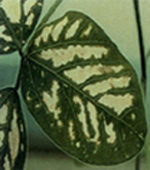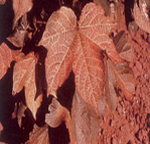Sulphurdioxide
Introduction
Sulphur dioxide! This classic, pre-eminent air pollutant is still with us. Produced from burning coal, Sulphur dioxide persists not so much from home heating as in the furnaces of coal-fired, electric power-generating plants. Particulate emissions may be over 99% controlled, and Sulphur dioxide may be 70-90% controlled in some countries, but older plants or newer facilities in developing countries often lack such technology. Even where controls exist, the tremendous amounts of coal burned still result in the emission of significant quantities of Sulphur dioxide. And despite pollution control equipment in modern smelters, the Sulphur dioxide emissions can still damage neighboring vegetation. The problem is especially critical in developing countries where control technology is lacking, or in developed countries where control has a low priority.
Injury Symptoms
Visible symptoms of Sulphur dioxide injury are no longer pervasive, but where controls are inadequate or break down, as they do on occasion, or when unusual meteorological conditions prevail that concentrate the emissions, plant damage can occur. The rapid breakdown of chlorophyll in the leaf cells results in characteristic chlorotic or necrotic markings. The basic cellular responses are similar for most species, but because of variations in their anatomy differences in specific symptoms are found on vegetable crops, cereals and coniferous plants.
Indicators
Plant sensitivity is based on presence of visible symptoms that make them useful as indicator plants in field studies.
Herbs/grasses/crops

The range of symptoms on dicotyledonous species is well illustrated by the response alfalfa (Medicago sativa L.). Alfalfa is one of the most sensitive and important species affected by sulfur dioxide. Markings most often consist of white or straw colored necrotic lesions extending through the leaf. The mildest acute symptoms, which can follow one exposure of 0.3-0.5 ppm (300-500 ppb)* for a few hours, consist of a narrow border of necrotic tissue along the margins or tip of the leaflet. Necrosis may be sharply delimited and often extends irregularly between the veins towards the midrib. At higher concentrations, or during conditions of high light intensity and humidity, necrosis is largely intercostal. Affected areas may be of any size or shape, ranging from minute flecks to involvement of most of the leaf area. When chlorosis occurs it ranges from an almost normal green to pale yellow in color. When the chlorophyll is only partially destroyed the cell may remain functional. Wheat and barley, notably the ‘flag’ leaves, are particularly sensitive to sulfur dioxide. Following 1-2 hours of exposure to concentrations as low as 0.3 ppm, leaf tips becomes gray-green to chlorotic; finally, they characteristically turn ivory-colored. Interveinal flecks or lesions often develop.
Coniferous tree
Acute visible injury affecting various parts of coniferous trees has been observed in response to SO2. Young needles show chlorosis and are poorly developed and stunted. Middle-aged needles often show yellow then red/brown discoloration succeeded by necrosis. Necrosis commonly affects the tip first but in larch and spruce the tip is often not the most sensitive part of the needle. Abscission of older needles in fir trees is frequently an immediate response but generally occurs after several months SO2 exposure in pine trees. SO2 exposure may bleach stems of young shoots.
Deciduous trees and shrubs
Larch is viewed as a particularly sensitive tree species to SO2.Taylor et al (1990) reported solely on leaf damage in broad-leaved trees and shrubs. Symptoms include interveinal chlorosis, irregular interveinal necrosis and abscission in many species. Necrosis characterized by brown/orange colouring has been revealed in lime, beech & hazel trees while black necrosis has been observed in pear trees. Distortion, puckering & curling of leaves has been detected in birch & maple.
Bryophytes

Application of sulphur pollutants as sulphate and bisulphite to bag vegetation reduced the growth of Sphagnum spp, (Ferguson & Lee 1980). Fumigation with SO2, 131mgm-3, under laboratory conditions (Ferguson, Lee and Bell 1978) showed that S. recurvum, a species still extant in the Pennines, was the most resistant to pollution effects on growth. More sensitive species, for example S. magellanicum, S. imbricatum, S. tonellum, had been eliminated from the area, and S. capillaceum and S. papillosum had become very uncommon, though these species had earlier formed major components of the peat bags in the Pennines. The authors suggested that SO2 pollution was contributory in causing the reduction in spicus composition. Nash and Nash (1974) showed that under laboratory conditions growth of Polytrichum ohioense protonemata was inhibited by SO2 concentrations of 0.59 mg/m3. Thus, high concentrations during periods of maximum growth and spore germination could restrict the spread of bryophytes.
Fungi
Schaffers and Termarshuizen (1989) obtained strong negative correlation between the number of mycorrhizal fungal species on field stands of Pinus sylvestris and the occurrence of fruit bodies on these species with levels of NH3 and SO2. Dowding and Richardson demonstrated the suitability of leaf yeasts for assessing air quality in both urban and rural areas of the non-Mediterranean countries of Europe. Leaf yeasts are found on a variety of leaves in temperate regions and actively discharge spores at right. Advantage of using leaf yeasts for air pollution monitoring are their sensitivity to SO2. Yeasts respond to SO2 levels in the range 0 to 100mg/m3.
List of Sensitive Species
| Table :-Plant Species sensitive to Sulphur Dioxide |
Crop plants
Alfalfa (Medicago sativa)
Barley (Hordeum vulgare)
Bean Field (Phaseolus sp.)
Clover (Melilotus trifolium sp.) |
Cotton (Gossypium sp.)
Oats (Avena sativa)
Rye (Secale cereale)
Safflower (Carthamus tinctorius) |
Soyabean (Glycine max)
Wheat (Triticum sp.) |
Ornamental Plants
Aster (Aster bigelovii)
Bachelor’s button (Centaurea cyanus)
Cosmos (Cosmos bipinnatus) |
Four o’clock (Mirabilis jalapa)
Morning glory (Ipomoea purpurea)
Sweet pea (Lathryus odoratus) |
Verbena (Verbena canadensis)
Voilet (Viola sp.)
Zinnia (Zinnia elegans) |
Trees
Apple (Malus sp.)
Birch (Betula sp.)
Catalpa (Catalpa speciosa) |
Larch (Larix sp.)
Mulberry (Morus microphylla)
Pear (Pyrus communis) |
Eastern white Pine (Pinus strobus)
Ponderosa Pine (Pinus ponderosa)
Poplar (Populus sp.) |
Garden plants
Bean (Phaseolus vulgaris)
Beet (Beta vulgaris)
Broccoli (Brassica oleracea)
Brussel sprouts (Brassica oleracea)
Carrot (Daucus carota)
Endive (Cichorium endivia) |
Lattuce (Lactuca sativa)
Okra (Hibiscus esculentus)
Pepper (Capsicum frutescens)
Pumpkin (Cucurbita pepo)
Radish (Raphanus sativus)
Rhubarb (Rheum rhaponticum) |
Spinach (Spinacea oleracea)
Squash (Cucurbita maxima)
Sweet potato (Ipomoea batatas)
Swiss chard (Beta vulgaris)
Turnip (Brassica rapa) |
Weeds
Bindweed (Convolvulus arvensis)
Buckwheat (Fagopyrum sagittatum)
Careless weed (Amaranthus palmeri)
Curly dock (Rumex crispus) |
Fleabane (Erigeron canadensis)
Prickly Lettuce (Lactuca scariola)
Mallow (Malva parviflora)
Plantain (Plantago major) |
Ragweed (Ambrosia artemisiifolia)
Sunflower (Helianthus)
Velvet-weed (Gaura parviflora)
Poison ivy (Rhus toxicodendron) |
| Source:-Plant stress from Air pollutation by- Micheal Treshow and Franklin K. Anderson 1989. John Wiley |
Biomontring
i. Species distribution surveys
Cape suggested that changes in composition of sensitive herbaceous species would be appropriate bioindications of air pollution in forest ecosystems. Similar decrease in the floristic composition of the herbaceous layer were observed in zones of increasing pollution around Shaktinagar Power Plant in India (Agrawal et al 1991). In 1996 the Swedish Environmental Protection Agency produced a report on the impacts of air pollutants on processing in small catchments which forms part of Sweden’s integrated monitoring network (Brakenhielm, 1996).
ii. Visible injury
Measurements of plant injury can be very complicated (e.g. injured vs. non injured) or more elaborate such as the application of numerical values or indices as measures of severity. Plant injury symptoms generally indicate acute damage to plants.
Factor Effecting Sensitivity
Many factors affect the sensitivity of plants/trees to SO2 (Taylor et al. 1990). Young fully expanded leaves/needles are more sensitive than older needles and generally seedlings are more sensitive than older plants. Drought, low temperature, N, S and P deficiency all reduce SO2 sensitivity whereas high relativity humidity, wind, K and Ca deficiency increase sensitivity.